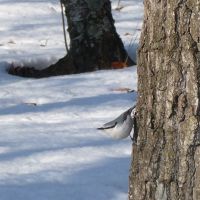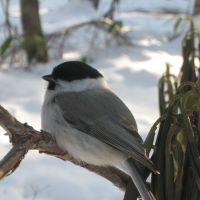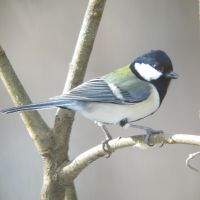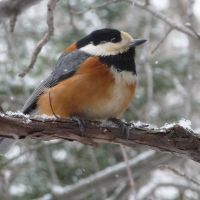A crescent moon is just visible through the treetops, with Venus, Jupiter and Saturn aligned diagonally above it crisp and clear in a frost-sharpened sky — planetary heralds of the peppering of stars soon to be revealed as night falls.
The mercury is plummeting as the day's warmth is sucked from the atmosphere, and soon it reaches minus 15. For many species, this is a time to be curled up tight in a tree hollow or burrow to escape the chill of night.
Not so a feather-blanket-clad Blakiston's Fish-owl perched close in beside a massive tree trunk leaning out from a snow-covered escarpment. Instead, it shakes and wakes from the soporific warmth of a long daytime slumber high in the tree. The enormous owl opens its large, baleful yellow eyes and blinks as it regards the stark winter scene.
Late February may bring plum blossoms and spring-like temperatures to Kyushu and western Honshu, but in Hokkaido it's a time of chill winds, blizzards and weeks when the thermometer doesn't even promise to rise toward zero. The fish-owl turns its head, and time passes; it surveys its riverine kingdom where snow and ice promise to reign supreme for another month or more.
Instincts combine with intimate knowledge of its home terrain; biological drives enmesh mental gears linked to familiarity and experience. It decides; it unfurls wings long as an eagle's, but broader and more silent, and launches itself into a slow-speed glide toward the nearby river.
Finding a new treetop perch, it surveys once more, its head swiveling in that uncanny detached way that owls have. One moment it faces forward, the next backward, its head having seemingly rotated almost 180 degrees.
Up there, its soft, earth-brown body feathers billow gently in the light evening breeze, and in its hunched posture it resembles a B-movie goblin in an oversized cloak. Its throat begins to bulge and the underfeathers show as a white signal in the very last of the fast-fading light. A moment later, its deep double hoot, as sonorous as it is timeless, booms out over the valley. Kotankorukamuy, the "god of the village" — as Ainu people regard it — has spoken.
Unseen by me, his mate has flown in to another tree nearby, and her solitary muffled hoot is appended so rapidly to his that it sounds as if just one bird has issued three notes.
Their duet lasts but moments before they move off suddenly around their territory. She, though, returns quickly, disappearing downstream to their nest site where, despite this still being winter in the north, they have eggs for her to incubate — and she must not let them chill.
I am astonished moments later to hear the guttural "ho-ho" of a foolhardy Ural Owl calling from a tree on the same riverside escarpment. Smaller than a fish-owl by almost half, it risks attack and death if it attempts to stake out territory here.
The male fish-owl meanwhile strangely ignores the Ural Owl and moves off alone around his territory, his role tonight being not to chase other owls but to catch fish for himself and to carry some back to his mate in their nest. Soon he's joined by the pair's full-grown youngster from last year who, still not fully independent, has remained in their territory. For a while this evening they move together along the river, but then separate to hunt apart.
When I survey the river next, by morning light, the temperature is still frigid, the river an untempting glassy black, but the owls have retreated from sight. Instead, a dumpy black bullet of a bird blurs past, low and fast, just above the rushing waters of the river. Its hard "djjiit" call, seeming to rattle against the clear ice at the river's edge like fast-falling pebbles, proclaims it to be a Brown Dipper. Its sooty blackish-brown mate sings its powerful, scratchy, thrush-like song from an ice-slicked boulder in midstream — proclaiming both its territory and its readiness to breed. The dippers, like the fish-owls, breed early, and both remain in their territory year-round.
Meanwhile, a long-billed shape, a Solitary Snipe, bobs deeply and slowly at the water's edge, its earthen and gray tones allowing it to blend into near-invisibility against the darkly shadowed water. As its name suggests, it is only ever encountered singly, and this individual will have arrived here from Russia to winter in the ranges of dippers and fish-owls alike.
Nearby, a dumpy, cock-tailed wren fossicks right in the open at the waterside, pecking insect larvae from among the gravel, looking just like a diminutive dipper — and behaving rather like one, too. The visual resemblance ends where its deep brown wings and tail are uncharacteristically white-coated with frost. But, like the dipper, the fish-owl and the snipe, the tiny wren spends most of its year alone or in its territory with its mate.
Whereas some creatures are comfortably at ease being alone, or remain for years only in the company of their mate and their offspring, others have a completely different take on (as Douglas "The Hitchhiker's Guide to the Galaxy" Adams would have said) "life, the universe and everything."
Hence many a small bird, while proudly proclaiming its territorial possession throughout the breeding season, is quick to abandon that unilateral territory as summer fades to autumn — and especially so as winter descends. That solitary and family-based spring and summer existence may be all very well while food is seasonally plentiful, or at least predictable in its location and availability. But then, once sustenance becomes more difficult to find in autumn, or perhaps abundant in one area yet scarce in another, they are happy to move in with the neighbors to share in the process of finding it.
A soft purring trill is a signal that nearby in the forest there is a Long-tailed Tit, and where there is one there are usually more — and where there are more, there are often other species too.
A harsh jarring "churr" confirms that a Marsh Tit is nearby too, so I give a soft squeaking call and instantly there is a flurry of movement in the trees around me. Tuft-capped Coal Tits and a couple of Varied Tits descend quickly from the conifers to check me out — giving thin sibilant calls as they do so. Marsh Tits and Eastern Great Tits are soon scolding me, relaying a message of alarm about this potential predator. Within moments they are joined by a Eurasian Nuthatch and a buzzing Japanese Pygmy Woodpecker. This roving band of some half-dozen species has materialized into existence around me, drawn by their commonality of concern — in this case about the danger I may represent.
During the brief days of winter, small forest birds face the unending task of finding sufficient food to keep them going during the short, cold days and to generate sufficient spare fat to tide them through the cold nights — this while facing down the multiple risks of cats, weasels, sable, foxes, sparrowhawks and goshawks.
Ganging together means they have more eyes and ears alert to danger, spreading the risk of being taken by a predator and increasing each bird's chance of locating rich pickings on the food front. They operate like a mobile collective, each harvesting from the forest in slightly different ways, and benefiting from being in an extended clan that not only includes their relatives, but unrelated individuals of their own species and others.
So, while one species in the flock forages over the trunks and branches, another scours the surface of twigs and buds; where one favors insect eggs and larvae secreted beneath bark and in crevices, another seeks out seeds, nuts and fruits that it will force into bark crevices so as to be able to hack them apart.
Their strategy could hardly be more different from that of the fish-owl or the dipper, yet they share the same habitat. They too live in the riverine forest through which owl and dipper move — though they see it in a very different light, and for them safety and security come in numbers.
For these small forest birds, the breeding season is weeks away — so they will remain at large, in their mixed-species flocks, until warming days and surging hormone-driven urges push them once more to break free of the gang lifestyle, stake out their own territories, and raise another brood.
Among many other things, it is learning of these differing strategies that species hit upon to solve similar life problems that helps make natural encounters so fascinating.
Mark Brazil, naturalist and author, has written Wild Watch for 29 years. He also organizes and leads wildlife, birding and photographic excursions around Japan, and is the founder of Japan Nature Guides. His latest book, "Field Guide to the Birds of East Asia," and his earlier "A Birdwatcher's Guide to Japan" and "The Birds of Japan" are all available at good bookstores or from the author via [email protected] or www.wildwatchjapan.com.






















With your current subscription plan you can comment on stories. However, before writing your first comment, please create a display name in the Profile section of your subscriber account page.